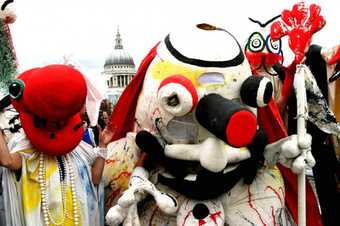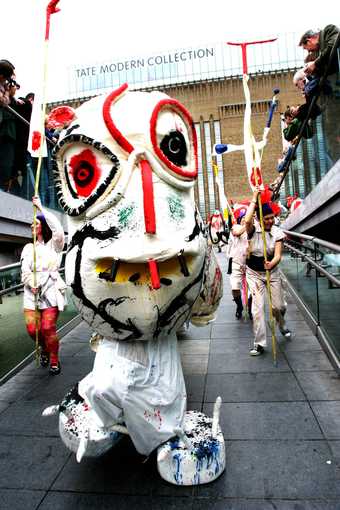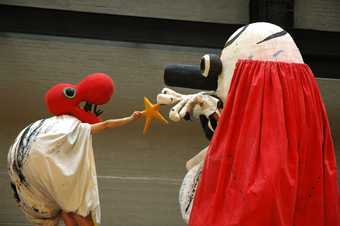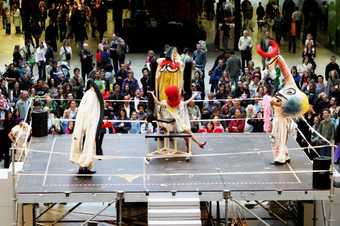Merma Never Dies by Joan Miró and Joan Baixas took place in 2006 during UBS Openings: The Long Weekend, the very first edition of Tate’s annual programme of live events. Performed on 27 May 2006 and forming the focal point of The Long Weekend’s Surrealist Saturday, Merma Never Dies was a puppet parade, which took place throughout the indoor and outdoor spaces at Tate, beginning on the Millennium Bridge and concluding in Tate Modern’s Turbine Hall.
First conceived in 1978 by the renowned surrealist painter Joan Miró in collaboration with La Claca, an experimental theatre troupe from Barcelona headed by Joan Baixas, this reinvention of the work for Tate was the first time the production had been performed in twenty-five years. Originally titled Mori el Merma (Death to Merma), the 1978 production was created in response to the death of Franco three years earlier and the end of his autocratic regime in Spain. Seeking to reflect upon the trauma of Spain’s recent history and also to celebrate the country’s release from Franco’s rule, Mori el Merma took the form of an avant-garde theatre production, using puppets designed by Joan Miró to tell an allegoric tale of despotic rule characterised by greed and cruelty but eventually overthrown by the public. The plot revolved around the adventures and misadventures of the central character Merma, a fictional crazed king, representative not only of Franco but also of all tyrannical leaders throughout history. Alfred Jarry’s 1896 play Ubu Roi (and its title character, the grotesque and violent Ubu the King) provided Miró with a dramaturgical blueprint. The production also featured an array of colourful supporting characters, including Merma’s wife and court, and a mob of angry, oppressed peasants, who eventually succeed in bringing down King Merma. Ranging from seven-foot giants with heads of monsters to diminutive creatures that whispered and squealed, the entire production looked as though it had sprang from the canvas of one of Miró’s paintings.
Although Baixas’s and Miró’s original production ended with the death and burial of Merma, the performance at Tate, as alluded to in its title, saw the return of the character, who it seemed twenty-five years on, was indestructible. In Merma Never Dies Merma and his Queen returned, greeted by a procession of visitors as they marched across the Millennium Bridge and down to the Turbine Hall, surrounded by their ministers and supporters who waved flags, played trumpets and banged drums in support of the apparent return of the king. Once inside the Turbine Hall, the characters took up their places on and around a stage-cum-boxing-ring in the centre of the space. From here Merma spouted his decrees, making fraudulent sounding promises to the audience and proclaiming the freedoms he afforded his people. At one point Merma made the entire Turbine Hall audience perform a series of physical actions, which he called ‘exercises of freedom’, burlesquing how mass control is often perversely asserted through a rhetoric of freedom or choice.
These scripted aspects of the production were interspersed with indecorous antics from the other characters, as well as displays of flatulence and general uncouthness by Merma, who in this version of the performance did not die at the end but simply fell asleep on the job. As he lay dormant, his brutish snores permeated through the Turbine Hall, signalling that the optimism of the original piece had been revised in the light of subsequent events. Joan Baixas’s new version of Merma highlighted the continued and continuing abuse of power by political figureheads. Speaking about the central character he said, ‘[t]he name is unimportant because, unfortunately, there are many Mermas now. In recent years we have seen leaders who wage wars with lies and who play games with democracy. The least we can do is laugh at them.’1
Clare Gormley
October 2015




